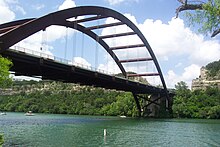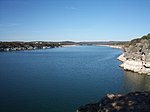Lake Austin
This article needs additional citations for verification. (April 2009) |
| Lake Austin | |
|---|---|
| Location | Austin, Texas |
| Coordinates | 30°17.66′N 97°47.18′W / 30.29433°N 97.78633°W |
| Lake type | Hydroelectric reservoir |
| Primary inflows | Colorado River |
| Primary outflows | Colorado River |
| Basin countries | United States |
| Surface area | 1,599 acres (647 ha) |
| Max. depth | 75 ft (23 m) |
| Surface elevation | 492 ft (150 m) above sea level |
Lake Austin, formerly Lake McDonald, is a water reservoir on the Colorado River in Austin, Texas in the United States. The reservoir was formed in 1939 by the construction of Tom Miller Dam by the Lower Colorado River Authority. Lake Austin is one of the seven Highland Lakes created by the Lower Colorado River Authority, and is used for flood control, electrical power generation, and recreation. Loop 360 spans the lake at the Pennybacker Bridge.
The other reservoirs on the Colorado River are Lake Buchanan, Inks Lake, Lake LBJ, Lake Marble Falls, Lake Travis, and Lady Bird Lake.

Recreational uses
Lake Austin is a popular fishing and boating destination. The lake is considered to have an excellent stock of largemouth bass. However, most people feel that the lake is best utilized for pleasure boating during the day.[1]
Fish and wildlife populations
Lake Austin has been stocked with several species of fish intended to improve the utility of the reservoir for recreational fishing. Fish present in Lake Austin include largemouth bass, catfish, and sunfish. Lake Austin is one of the Texas Highland Lakes infested with hydrilla, a non-native aquatic plant species. The Lower Colorado River Authority has intentionally lowered the water levels in the lake in the months of January and February so that freezing air temperatures might destroy substantial portions of the hydrilla in the lake each winter. As of March 2014, hydrilla has been completely eliminated from the lake through the stocking of Asian Grass Carp by the City of Austin.[2]
References
- ^ Texas Parks and Wildlife. "Fishing Lake Austin". Retrieved 19 January 2012.
- ^ "Hydrilla plant gone from Lake Austin". KVUE. Retrieved 14 May 2014.
External links
- Lake Austin - Texas Parks & Wildlife
- U.S. Geological Survey Geographic Names Information System: Lake Austin

